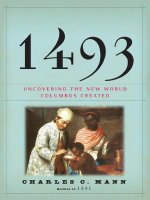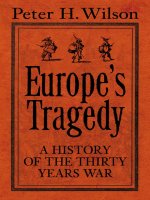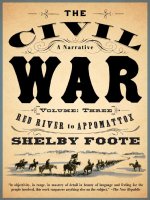Peter h wilson europes tragedy a new histor war (v5 0)
Bạn đang xem bản rút gọn của tài liệu. Xem và tải ngay bản đầy đủ của tài liệu tại đây (8.85 MB, 928 trang )
PETER H. WILSON
Europe’s Tragedy
A History of the Thirty Years War
ALLEN LANE
an imprint of
PENGUIN BOOKS
ALLEN LANE
Published by the Penguin Group
Penguin Books Ltd, 80 Strand, London WC2R 0RL, England
Penguin Group (USA) Inc., 375 Hudson Street, New York, New York 10014, USA
Penguin Group (Canada), 90 Eglinton Avenue East, Suite 700, Toronto, Ontario, Canada M4P 2Y3
(a division of Pearson Penguin Canada Inc.)
Penguin Ireland, 25 St Stephen’s Green, Dublin 2, Ireland
(a division of Penguin Books Ltd)
Penguin Group (Australia), 250 Camberwell Road, Camberwell, Victoria 3124, Australia
(a division of Pearson Australia Group Pty Ltd)
Penguin Books India Pvt Ltd, 11 Community Centre, Panchsheel Park, New Delhi – 110 017, India
Penguin Group (NZ), 67 Apollo Drive, Rosedale, North Shore 0632, New Zealand
(a division of Pearson New Zealand Ltd)
Penguin Books (South Africa) (Pty) Ltd, 24 Sturdee Avenue, Rosebank, Johannesburg 2196, South Africa
Penguin Books Ltd, Registered Offices: 80 Strand, London WC2R 0RL, England
www.penguin.com
First published 2009
1
Copyright © Peter H. Wilson, 2009
The moral right of the author has been asserted
The endpaper map was originally drawn by Reginald Piggott for a reissue of C. V. Wedgwood’s
The Thirty Years War (1938) and retains a handful of variant place-name spellings.
It is reproduced courtesy of the Folio Society.
All rights reserved.
Without limiting the rights under copyright reserved above, no part of this publication may be reproduced, stored in or
introduced into a retrieval system, or transmitted, in any form or by any means (electronic, mechanical, photocopying,
recording or otherwise) without the prior written permission of both the copyright owner and the above publisher of this
book
A CIP catalogue record for this book is available from the British Library
ISBN: 978-0-14-193780-9
For my family
Contents
List of Illustrations
List of Maps and Battle Plans
List of Tables
Note on Form
The Habsburg Family Tree 1500–1665
Note on Currencies
Preface
PART ONE
Beginnings
1 Introduction
Three Men and a Window
Interretations
The Argument
2 Trouble in the Heart of Christendom
The Empire
Confessionalization
Religion and Imperial Law
3 Casa d’Austria
Lands and Dynasty
Estates and Confession
The Catholic Revival
4 The Turkish War and its Consequences
The Turkish Menace
The Ways of War
The Long Turkish War
The Brothers’ Quarrel
5 Pax Hispanica
The Spanish Monarchy
The Dutch Revolt 1568–1609
The Spanish Road
Spanish Peace-making
6 Dominium Maris Baltici
Denmark
The Divided House of Vasa
Poland-Lithuania
7 From Rudolf to Matthias 1582–1612
Religion and the German Princes
Confession and Imperial Politics to 1608
Union and Liga 1608–9
The Jülich-Cleves Crisis 1609–10
8 On the Brink?
Emperor Matthias
The Uskok War and the Habsburg Succession 1615–17
Palatine Brinkmanship
PART TWO
Conflict
9 The Bohemian Revolt 1618–20
For Liberty and Privilege
A King for a Crown
Ferdinand Gathers his Forces
White Mountain
Accounting for Failure
10 Ferdinand Triumphant 1621–4
The Palatine Cause
Protestant Paladins
The Catholic Ascendancy 1621–9
11 Olivares and Richelieu
Olivares
Richelieu
The Valtellina
12 Denmark’s War against the Emperor 1625–9
Trouble in Lower Saxony
Wallenstein
Denmark’s Defeat 1626–9
13 The Threat of European War 1628–30
The Baltic
The Netherlands
Mantua and La Rochelle
The Edict of Restitution
The Regensburg Electoral Congress 1630
14 The Lion of the North 1630–2
Swedish Intervention
Between the Lion and the Eagle
The Swedish Empire
Calls for Assistance
Zenith
15 Without Gustavus 1633–4
The Heilbronn League
Tension along the Rhine
Sain Intervenes
Wallenstein: the Final Act
The Two Ferdinands
16 For the Liberty of Germany 1635–6
Richelieu Resolves on War
The War in the West 1635–6
The Peace of Prague 1635
Appeals to Patriotism
Renewed Efforts for Peace
17 Habsburg High Tide 1637–40
Stalemate
Resolution on the Rhine
Peace for North Germany?
18 In the Balance 1641–3
The Franco-Swedish Alliance 1641
The War in the Empire 1642–3
Spain’s Growing Crisis 1635–43
From Breda to Rocroi 1637–43
19 Pressure to Negotiate 1644–5
The Westphalian Congress
France in Germany 1644
The Baltic Becomes Swedish 1643–5
1645: Annus horribilis et mirabilis
20 War or Peace 1646–8
A Crisis of Confidence 1646
Towards Consensus
Spain’s Peace with the Dutch
The Final Round 1648
PART THREE
Aftermath
21 The Westphalian Settlement
The International Dimension
A Christian Peace
Demobilization
The Imperial Recovery
22 The Human and Material Cost
An All-destructive Fury?
The Demographic Impact
The Economic Impact
The Crisis of the Territorial State
Cultural Impact
23 Experiencing War
The Nature of Experience
Military–Civil Relations
Perceptions
Commemoration
Abbreviations
Notes
Index
List of Illustrations
Photographic acknowledgements are given in parentheses. Every effort has been made
to contact all copyright holders. The Publishers will be happy to make good in future
editions of this book any errors or omissions brought to their attention.
1 The Defenestration of Prague in 1618, engraving by Matthaeus Merian the Elder, from
Theatrum Europaeum, Frankfurt, 1662 (Universitätsbibliothek Augsburg)
2 Persecution of Christians, 1622, from a contemporary pamphlet (Harry Ransom
Humanities Research Center, University of Texas at Austin)
3 Nördlingen, engraving from Matthaeus Merian, Topographia Germania, Frankfurt, 1643
4 Friedenswünsch, from Merian, Topographia Germania
5 Coat of Arms of the Imperial City of Buchhorn, 1619 (Stadtgeschichtliche Sammlungen,
Stadt Friedrichshafen; photograph copyright © Toni Schneiders)
6 The Crown of Rudolf II (detail), 1602, by Jan Vermeyen (Kunst-historisches Museum,
Vienna)
7 Emperor Ferdinand II. Bildarchiv der Österreichischen (Nationalbibliothek, Vienna;
photograph courtesy ÖNB/Wien)
8 The Mystical Marriage of St Katherine, with Emperor Matthias as the Apostle Matthew with
Empress Anna as St. Helena, 1614, by Matthäus Gundelach (Schloss Ambras, Vienna;
photograph courtesy Kunsthistorisches Museum, Vienna)
9 Musketeers, from Hans Conrad Lavater, Kriegs-Büchlein, Zurich, 1644
10 Arquebusiers performing a caracole, from Hermann Hugo, De militia equestri antiqua
et nova ad regem Philippum IV, Antwerp, 1630 (photograph courtesy Chetham’s Library,
Manchester)
11 Archduchess Isabella, c. 1616–17, by Peter Paul Rubens and Jan Brueghel (Museo
Nacional del Prado, Madrid; photograph courtesy AISA )
12 Gustavus Adolphus, copy of an undated sketch by ‘L.S.’ (Germanisches
Nationalmuseum, Nuremberg)
13 Chancellor Axel Oxenstierna of Sweden, 1635, copy after Michiel Jansz. van
Miereveldt (Copyright © The National Museum of Fine Arts, Stockholm)
14 Maximilian I, c. 1620, by an unknown artist (Bayerische
Staatsgemaeldesammlungen, Munich; photograph courtesy akg-images)
15 Frederick V, as Frederick I King of Bohemia, c. 1619, by Gerrit van Honthorst
(Collection of the Duke of Buccleuch and Queensberry; photograph courtesy akg-images)
16 Christian von Anhalt, engraving from Merian, Theatrum Europaeum
17 Johann Tserclaes, Count of Tilly, c. 1620, by an unknown artist (Landesmuseum,
Brunswick; photograph courtesy akg-images)
18 Execution of the Bohemian Rebels by the Prague Blood Court, 21 June 1621, from a
contemporary pamphlet (photograph courtesy akg-images)
19 Christian of Brunswick, 1619, by Paulus Moreelse (Herzog Anton Ulrich-Museum,
Brunswick; photograph courtesy akg-images)
20 The Battle of Stadtlohn, 1623, from a contemporary pamphlet (Germanisches
Nationalmuseum, Nuremberg)
21 The Siege of Breda, from Merian, Theatrum Europaeum (Universitätsbibliothek
Augsburg)
22 Gustavus Adolphus and Johann Georg of Saxony, 1631 (Germanisches
Nationalmuseum, Nuremberg)
23 Albrecht von Wallenstein, c. 1626, by Kristian Kaulfersch (Frýdlant Castle, Czech
Republic; photograph courtesy Deutsche Fotothek)
24 Gustavus Adolphus landing in Pomerania, 1630, by Georg Köler (Germanisches
Nationalmuseum, Nuremberg)
25 The Death of Gustavus II Adolphus during the Battle of Lützen (detail), 1632, by Jan
Asselijn (Herzog Anton Ulrich-Museum, Brunswick; photogrpah courtesy akgimages/ullstein bild)
26 Wallenstein’s letter, stained with Pappenheim’s blood, 1632 (Heeresgeschichtliches
Museum, Vienna)
27 Queen Christina of Sweden, 1634, studio of Jacob Heinrich Elbfas (copyright © The
National Museum of Fine Arts, Stockholm)
28 Murder of Wallenstein and his officers in Eger on 25 February 1634, from Merian,
Theatrum Europaeum (photograph courtesy akg-images)
29 Emperor Ferdinand III, undated engraving (Bildarchiv der Österreichischen
Nationalbibliothek, Vienna; photograph courtesy ÖNB/Wien)
30 Amalia Elisabeth of Hessen-Kassel, from Merian, Theatrum Europaeum
31 The Battle of the Downs against the Spanish Armada, 21 October 1639 (detail) by Willem
van der Velde the Elder (Rijksmuseum, Amsterdam)
32 Maximilian Count Trautmannsdorff, by an unknown artist (copyright © The National
Museum of Fine Arts, Stockholm)
33 Dedication of the Marian Column in Munich, seventeenth-century engraving
(photograph courtesy Bildarchiv Foto Marburg)
34 Seven Bavarian Soldiers Giving Thanks After the Battle of Alerheim, 1651, south German
School (Schloss Baldern, Bopfingen-Württemberg)
35 Memento Mori, by Hans Ulrich Franck (Kunsthalle, Bremen)
36 A Cavalryman Waylaid in a Forest, 1643, by Hans Ulrich Franck (Staatliche
Kunstsammlungen, Dresden; photograph courtesy Deutsche Fotothek)
37 Soldiers Plundering a Village, 1643, by Hans Ulrich Franck (Kupferstichkabinett,
Kunsthalle, Bremen)
38 Drawing of the flag of Captain Concin’s company of Count Hardegg’s imperial
infantry regiment, 1632 (Niederösterreichisches Landesarchiv, Vienna)
39 Peace Celebrations, Nuremberg, 1650, from Merian, Theatrum Europeaum
(Germanisches Nationalmuseum, Nuremberg)
40 The Ratification of the Treaty of Münster, 15 May 1648, by Gerhard ter Borch
(Rijksmuseum, Amsterdam)
List of Maps and Battle Plans
Maps
1 Central Europe, 1618
2 The Valtellina and Swiss passes
Battle Plans
1 White Mountain 1620
2 Wimpfen 1622
3 Höchst 1622
4 Stadtlohn 1623
5 Lutter 1626
6 Stralsund 1628
7 Mantua 1630
8 Breitenfeld 1631
9 The Lech 1632
10 Steinau 1632
11 Alte Veste 1632
12 Lützen 1632
13 Hessisch-Oldendorf 1633
14 Nördlingen 1634
15 Wittstock 1636
16 Rheinfelden 1638
17 Wittenweier 1638
18 Wolfenbüttel 1641
19 Second Breitenfeld 1642
20 Tuttlingen 1643
21 Freiburg 1644
22 Jankau 1645
23 Herbsthausen 1645
24 Allerheim 1645
25 Zusmarshausen 1648
List of Tables
1 British military involvement
2 Possession of the North German bishoprics c. 1590–1650
3 Strength of the imperial army
4 Regiments of the imperial army 1618–30
5 The territorial settlement
6 Military strength in the Empire, October 1648
7 Comparative total deaths in major conflicts
8 Population change in the Habsburg monarchy 1600–50
Note on Form
Place names are given in the form most commonly used in English-language writing.
For east Central European locations, this tends to be the German version. The current
name is given in parenthesis at the first mention. Individuals are identified in the text
using their first name and the title by which they are best known. Full names and titles,
along with dates of birth and death (where known) are given for each person in the
index. Emperor Ferdinand II’s general has become known as Wallenstein since Schiller’s
drama trilogy at the end of the eighteenth century. This version has entrenched itself in
English writing and will be used here rather than the Czech original, Waldstein. In
contemporary documents, he generally appears as ‘the Friedländer’ after his duchy of
Friedland. Though anachronistic, the term ‘Britain’ will be used for the lands of the
Stuart monarchy in preference to the still more misleading ‘England’, unless it is
intended to refer to the individual kingdoms or principalities. All dates are given in the
New Style according to the Gregorian calendar introduced into the Catholic parts of
Europe and the Holy Roman Empire around 1582. This was ten days ahead of the Julian
calendar retained by Protestant Germans generally until 1700.
The Habsburg Family Tree 1500–1665
Note on Currencies
Currency
Equivalent
Escudo (Spain)
1.1 ducats (Spain, from 1620), or 2.5 fl. (Dutch)
Ducat (Spain)
2.35 fl. (Dutch), or 1.4 fl. (German)
Ducat (Naples)
0.7 ducat (Spain)
Florin (German)
1.7 fl. (Dutch)
Livre (French)
initially 0.7 fl. (German); 0.5 fl. after 1640
Pound sterling
4.2–4.8 talers
Riksdaler (Denmark/Sweden) 1–1.5 fl. (German)
Taler (Empire)
1.5 fl. (German), or 2.5 fl. (Dutch)
It is difficult to give modern equivalents to seventeenth-century currency. As a guide to
value, 7.5–10 florins would buy enough grain to feed a person for a whole year in 1618.
Preface
The history of the Thirty Years War is rich in specialist studies, but poor in general
accounts. Few authors provide more than short overviews intended for students. It is
easy to see why. To cover all aspects would require knowledge of at least fourteen
European languages, while there are sufficient archival records to occupy many
lifetimes of research. Even the printed material runs to millions of pages; there are over
4,000 titles just on the Peace of Westphalia that concluded the conflict. The sheer
volume of evidence has affected how previous histories have been written. Some cut
through the detail by fitting the war into broader explanations of Europe’s transition to
modernity. Others give more scope to personalities and events but often signs of fatigue
set in as the author approaches the mid-1630s. By then the heroes and villains giving life
to the opening phases were largely dead, replaced by other figures ignored by posterity.
There is a rush to wrap up the story and the last thirteen years are compressed into a
quarter or less of the text, much of which is devoted to discussing the peace and
aftermath.
The present work seeks to redress this through a more even coverage across the entire
time span. Some of the distinctive features of this approach are set out in the
introductory chapter. The most important is to view the war on its own terms as a
struggle over the political and religious order of Central Europe, rather than submerging
it within a general account of European conflict throughout the first half of the
seventeenth century. While this simplifies some aspects, it also directs attention to the
war’s origins in the complex situation in the Holy Roman Empire during the later
sixteenth century. The task of the first part of the book is to explain this and place it in
the wider European context. The second part follows the unfolding tragedy roughly
chronologically, paying particular regard to why peace-making efforts failed before the
mid-1640s. The final part examines the war’s political, economic, social and cultural
impact and longer-term significance. Throughout, structural explanations have been
combined with an emphasis on agency and contingency, giving more space than
customary to minor as well as more prominent participants. Referencing is selective,
excluding much of the older material used in favour of recent works that are more
accessible for most readers and provide a useful guide to the specialist literature.
It is a great pleasure to acknowledge the support of the Arts and Humanities Research
Council for a Research Leave Award in 2007–8 that enabled this book to be completed. I
have also benefited from a supportive research environment during my time at the
University of Sunderland, as well as a warm welcome by the History Department at Hull
where the final sections were written. Leopold Auer and the staff of the Haus-, Hof- und
Staatsarchiv Vienna provided valuable assistance during my all-too-brief visit in 2006. I
am grateful to Scott Dixon, Robert Evans, Ralph Morrison and Neil Rennoldson for their
help in locating obscure works, and especially to Kacper Rekawek for assisting with
Polish-language material. Clarissa Campbell Orr, Tryntje Helfferich, Michael Kaiser,
Maureen Meikle, Géza Pálffy and Ciro Paoletti all generously shared their knowledge on
numerous points of detail. I am particularly indebted to Trevor Johnson for providing a
pre-publication version of his book on Bavarian policy. Sadly, his sudden death in 2007
means I am no longer able to reciprocate.
Simon Winder’s encouragement sustained my faith that the book would eventually be
completed, while his editorial advice greatly improved its clarity. Charlotte Ridings’
careful copyediting rooted out inconsistency and error, and Cecilia Mackay transformed
my wish-list of illustrations into reality.
Eliane, Alec, Tom and Nina patiently tolerated my immersion in the past and, as
usual, have provided the greatest assistance and inspiration. This book is dedicated to
them with love.
PART ONE
Beginnings
1
Introduction
THREE MEN AND A WINDOW
Shortly after 9 a.m. on Wednesday 23 May 1618, Vilém Slavata found himself hanging
from a window of the Hradschin castle in Prague. This was not a predicament the 46year-old aristocrat had encountered before. As president of the Bohemian treasury and a
supreme court judge, he was a senior figure in the royal government with a
distinguished career in the service of the ruling Habsburg dynasty. Thanks to his
marriage to the heiress Lucia Ottilia, he was also one of the richest men in the entire
kingdom.
Moments before, his equally distinguished colleague, Jaroslav Borita von Martinitz,
had been seized by five armed men. Martinitz’s pleas to be allowed a confessor had
merely enraged his assailants who flung him unceremoniously headfirst from the same
window from which Slavata now clung, dangling precariously above the seventeenmetre drop to the ditch below. Angry voices in the room indicated no prospect of human
help. At that moment, Slavata felt the sharp cut of metal as someone smacked a sword
hilt against his fingers. The pain became too much; his grip loosened and he plummeted
downward, cracking the back of his head open on the sill of a lower window. As he
disappeared into the void, his attackers noticed his secretary, Philipp Fabricius, his arms
clutched around one of the less intimidating members of the gang. Ignoring his pleas for
mercy, he was summarily despatched out of the window to share his master’s fate.
That, however, turned out other than intended. While Slavata landed squarely at the
bottom of the ditch, Martinitz had fallen further up. He now slithered down to help his
friend, injuring himself on the way down with his own sword that his attackers had
neglected to unbuckle. Shots rang out from the window above, but Martinitz managed
to help the dazed Slavata to his feet and together they escaped to the nearby Lobkowitz
palace, home of the Bohemian chancellor who had been absent from their disrupted
meeting. Two men were sent to finish them off, but Lobkowitz’s wife, Polyxena, bolted
the door and eventually persuaded them to go away. Martinitz fled across the frontier to
Bavaria the next day, but Slavata’s injuries prevented him from leaving immediately
and he was forced to hide. Fabricius, who, amazingly, had landed on his feet,
meanwhile raced to Vienna, heart of the Habsburg monarchy and political centre of the
Holy Roman Empire, to alert the emperor.1
This event has entered history as the Defenestration of Prague that triggered the
Bohemian Revolt, the commonly accepted start of the Thirty Years War that claimed
eight million lives and transformed the political and religious map of Europe. The war
occupies a place in German and Czech history similar to that of the civil wars in Britain,
Spain and the United States of America, or the revolutions in France and Russia: a
defining moment of national trauma that shaped how a country regards itself and its
place in the world. The difficulty for later generations in coming to terms with the scale
of the devastation has been compared to the problem of historicizing the Holocaust.2 For
most Germans, the war came to symbolize national humiliation, retarding political,
economic and social development and condemning their country to two centuries of
internal division and international impotence.
INTERPRETATIONS
This interpretation originated in a much later defeat that both revived interest in the
Thirty Years War and transformed how it was regarded. For those who lived through it,
and their children, the war retained the immediacy of contemporary events. From the
outset, the conflict attracted wide interest across Europe, accelerating the early
seventeenth-century ‘media revolution’ that saw the birth of the modern newspaper (see
Chapter 23). The concluding Peace of Westphalia was an international bestseller,
running through at least thirty editions within a year. Interest gradually dissipated
towards the end of the seventeenth century as Central Europe entered another thirty
years of war, mainly against France and the Ottoman Turks. The memory of the earlier
conflict continued to be kept alive, however, in annual festivities celebrating the Peace
of Westphalia, as well as through a relatively small number of books intended for a
popular market. Like the public ceremonies, these works presented a broadly positive
interpretation of the war’s outcome in preserving the liberties of Protestant Germans
and strengthening the imperial constitution.3
The view darkened dramatically in the wake of the French Revolution and Napoleon’s
dismemberment of the Holy Roman Empire. The Austro-Prussian counter-attack against
Revolutionary France in 1792 dragged Germans into another cycle of invasion, defeat,
political upheaval and devastation. These experiences coincided with new intellectual
and cultural currents associated with Romanticism and the literary ‘Storm and Stress’
movement. Lurid tales of mass death, rape and torture from the Thirty Years War had
an immediate resonance, while the dramatic lives of individuals like the imperial
general Wallenstein, or Sweden’s King Gustavus Adolphus, assumed new meaning
through comparison with Napoleon and other contemporary figures. Friedrich Schiller,
the leading Storm and Stress writer, found an eager audience when he published his
history of the war in 1791, followed by his Wallenstein trilogy in 1797–9 which remains
the equivalent of Shakespeare’s history plays for the German-speaking world.
The Romantic reinterpretation of the war established three elements that still shape
writing today. One is a Gothic preoccupation with death, decline and destruction, with
Germany usually presented as the helpless victim of foreign aggression. Atrocity stories
were culled from folk tales and contemporary fiction, notably The Adventures of
Simplicius Simplicissimus by Grimmelshausen, which was rediscovered by the Romantic
poets as the first authentic German novel and reissued in numerous ‘improved’ editions
in the early nineteenth century.4
The reappearance of these tales in historical novels and paintings, as well as school
history lessons, reinforced folk memory and family tradition, not only in Germany but
in other countries affected by the fighting. The Thirty Years War became the benchmark
to measure all later wars. The inhabitants of eastern France interpreted each subsequent
invasion in the light of stories told about the Swedes and Croats who devastated their
region in the 1630s. Soldiers fighting in the trenches along the eastern front of the First
World War believed they were experiencing horrors not seen in three centuries. In his
radio broadcast on 4 May 1945, Hitler’s architect and armaments minister, Albert Speer,
announced ‘the destruction that has been inflicted on Germany can only be compared to
that of the Thirty Years War. The decimation of our people through hunger and
deprivation must not be allowed to reach the proportion of that epoch.’ For this reason,
he went on, Hitler’s successor, Admiral Dönitz, had given the order to lay down arms.
Public opinion surveys carried out in the 1960s revealed that Germans placed the Thirty
Years War as their country’s greatest disaster ahead of both world wars, the Holocaust
and the Black Death.5
The impact of TV undoubtedly shifted this perception in the later twentieth century,
especially through the dissemination of photographic images of more recent carnage.
Nonetheless, even in the twenty-first century, German authors could assert that ‘never
before and also never since, not even during the horrors of the bombing during the
Second World War, was the land so devastated and the people so tortured’ as between
1618 and 1648.6
The second feature established by nineteenth-century historiography is the air of
tragic inevitability. This is already apparent in Schiller’s Wallenstein, which presents its
central figure as an idealistic hero seeking peace but doomed to be murdered by his
closest subordinates. The sense of unstoppable descent into chaos became general in
writing after the Napoleonic Wars. The earlier positive reception for the Peace of
Westphalia seemed inappropriate given the Empire’s demise in 1806. Far from
strengthening the imperial constitution, the war now seemed to have started its
unravelling. More recent work reinforces this impression by shifting attention from
personalities and constitutional failure to the long-term transition of the European
economy from feudalism to capitalism that allegedly triggered the ‘General Crisis of the
Seventeenth Century’.7 Others see the crisis as primarily political, environmental, or a
combination of two or more factors. All versions, however, claim that underlying
structural change stoked tensions that exploded into violent revolts and international
conflict across Europe after 1600.8
Disagreements over the interpretation of these events in the Empire produced the
third and probably most influential element in nineteenth-century German writing. The
history of the Thirty Years War became enmeshed in the controversy surrounding
German development after 1815. Two competing narratives emerged, each associated
with one of the possible future Germanies. The ‘Greater German’ solution envisaged a
loose federation that included Habsburg Austria as well as Hohenzollern Prussia and the
‘third Germany’ of the smaller states like Bavaria, Nassau and Württemberg. The ‘Lesser
German’ alternative excluded Austria, largely because of the complications of
incorporating the Habsburgs’ other subjects in Italy and the Balkans. The Lesser German
solution triumphed with Prussia’s victory over Austria in 1866 and was consolidated
with the defeat of France in 1870–1, establishing the Second Reich. Both visions for
Germany’s future had clear religious associations that were transposed onto the dispute
over the country’s past. The assumption that the Thirty Years War had been a religious
conflict seemed so self-evident it was scarcely questioned.
It proved highly significant that the conflict over German statehood coincided with
the birth of modern historical scholarship. Leopold von Ranke, the founder of the
German empirical school, chose Wallenstein as the subject of the only full biography
among his extensive publications. Ranke and his contemporaries made a real effort to
study the surviving archival material, and much of their writing remains of great value.
They profoundly influenced how historians in other countries interpreted the war,
though each country also fitted the conflict into its own national narrative. French
historians generally saw it through the lens of Richelieu and Mazarin, whose policies
reputedly laid the foundations for the era of ‘French preponderance’ over the continent
from the mid-seventeenth century to Napoleon. For Spanish writers, the theme was one
of national decline as their country appeared to have overreached itself after 1618. The
Swiss, Dutch and Portuguese associated the conflict with national independence, in each
case from the Habsburg monarchy, while Danes and Swedes placed it in the context of
their mutual rivalry over the Baltic. British interpretations remained closest to the
German view, partly because the Stuart dynasty was associated with the elector
Palatine’s fateful decision to support the Bohemian rebels after the Defenestration.
Many contemporaries saw this dynastic link in religious terms as the ‘Protestant Cause’,
something that was echoed in the confessionalized writing of nineteenth-century
Germans whose works provided the main sources for historians working in Britain.9
The idea of a religious war also fitted the broader Protestant narrative behind much
nineteenth- and early twentieth-century historical writing that viewed events following
the Reformation as liberation from the Catholic yoke. The same progressive trajectory
could also be presented without a confessional bias as one of secularization and
modernization. In one recent account, the war becomes the ‘developmental and
modernisation crisis’ of European civilization; an ‘inferno’ that produced the modern
world.10
It is a commonplace in historical writing and political science that the Westphalian
settlement initiated the system of sovereign states that came to structure international
relations around the globe. Military historians routinely credit key figures like Gustavus
Adolphus as the ‘fathers’ of modern warfare. Politically, the war is believed to have
fostered an era of absolute monarchy that dominated much of the continent until the
French Revolution. The Europeans exported their quarrels to the Caribbean, Brazil,
western Africa, Mozambique, Sri Lanka, Indonesia and the Atlantic and Pacific Oceans.
The silver that paid the soldiers of Catholic Europe was mined in appalling conditions
by Mexicans, Peruvians and Bolivians, many thousands of whom can be numbered
among the war’s victims. African slaves toiled in Brazil for Dutch sugar planters whose
profits helped finance their republic’s struggle with Spain, along with money from the
Baltic grain trade and North Sea fisheries.
Interest in this wider dimension has come to dominate writing in English on the war
that presents events in the Empire as part of a wider struggle of France, Sweden and
English, Dutch and German Protestants against Spanish-Habsburg hegemony. The war
in the Empire was either an adjunct of this larger conflict, or became part of it once
Sweden and France intervened in Germany in the 1630s. Though one leading exponent
dismisses the older German interpretation as ‘parochial’, this international war school
remains strongly influenced by nineteenth-century historiography, presenting the
outbreak as inevitable, and the conduct characterized by escalating violence and
religious animosity.11
THE ARGUMENT
The Thirty Years War was an extremely complex event. The problems of interpretation
derive from attempts to simplify it by overemphasizing one facet to the detriment of
others. The present book seeks to reconnect the different elements through their
common relationship to the imperial constitution. The war in the Empire was related to
other conflicts, but nonetheless remained distinct. Observers even outside the Empire
believed the struggle that began with the Bohemian Revolt continued until the Peace of
Westphalia. They began talking of a five or six years war in the early 1620s and
continued counting until its conclusion in 1648.12
Nonetheless, all Europe was affected and the course of the continent’s history would
have been very different had the war been avoided, or had another outcome. Of the
major states, only Russia remained uninvolved. Poland and the Ottoman empire
exercised a significant influence without engaging directly. The Dutch just managed to
keep their own conflict with Spain separate, while trying to shape events in the Empire
with limited indirect assistance. British engagement was more substantial, without that
state ever becoming a formal belligerent. France and Spain intervened, but kept their
participation separate from their own mutual struggle that had separate origins and
continued another eleven years beyond 1648. Denmark and Sweden were full
belligerents, though their intervention had little to do with the war’s origins. Likewise,
other neighbouring principalities like Savoy and Lorraine were drawn in, without losing
sight of their own agendas and regional squabbles.
The second major distinction of the present argument is that it was not primarily a
religious war.13 Religion certainly provided a powerful focus for identity, but it had to
compete with political, social, linguistic, gender and other distinctions. Most
contemporary observers spoke of imperial, Bavarian, Swedish, or Bohemian troops, not
Catholic or Protestant, which are anachronistic labels used for convenience since the
nineteenth century to simplify accounts. The war was religious only to the extent that
faith guided all early modern public policy and private behaviour. To understand the
conflict’s true relationship to the disputes within Christianity, we need to distinguish
between militant and moderate believers. All were religious and we should not see
moderates as necessarily more rational, reasonable or secular. The difference lay not in
their religious zeal, but how they related faith and action. All were convinced their
version of Christianity offered the only true path to salvation and the sole correct guide
to justice, politics and daily life. Moderates, however, were more pragmatic, regarding
the desired reunification of all Christians within a single church as a general, rather
distant objective. Militants saw this goal as within their grasp and were not only
prepared to use force rather than persuasion but also felt personally summoned by God
to do so. They interpreted the Bible in providential, apocalyptical terms, relating
current events directly to the text. For them, the conflict was a holy war; a cosmic
showdown between good and evil in which the ends justified almost any means.
As we shall see, militants remained the minority, largely experiencing the war as
observers or victims of defeat and displacement. Nonetheless, then as now, militancy
proves especially dangerous when combined with political power. It creates a delusional
sense in those who rule of being chosen by God for a divine purpose and reward. It
encourages the conviction that their norms alone are absolute, their form of government
is automatically superior to all others and their faith is the only really true religion. Such
fundamentalists demonize ‘the other’ as evil in the psychological equivalent of declaring
war, cutting off all possibility of dialogue or compromise. They no longer feel obliged to
treat opponents as human beings. Problems to which they might have contributed are
blamed entirely on the enemy. But such self-confidence is inherently dangerous to
themselves as well as their enemies. The belief in divine assistance encourages
fundamentalists to take risks, convinced that mounting odds are merely part of God’s
plan to test their faith. They remain convinced that ultimate victory is theirs by right.
This can stiffen resolve and motivate stubborn resistance, but it is poorly suited to
achieving military success. Fundamentalists have no real knowledge of their opponents,
whom they make no effort to understand. These beliefs certainly shaped key decisions,
including the Defenestration and the elector Palatine’s decision to join the Revolt.
Militants’ influence was at times disproportionate to their numbers, but this does not
mean we should interpret the conflict through their eyes.
The third key distinction of the present argument is that the war was not inevitable.
The link between seventeenth-century European strife with wider environmental and
economic problems is circumstantial at best. The entire continent was not convulsed by
a general wave of violence. Despite sharing similar underlying problems with the war
zone, much of the Empire remained at peace after 1618, until the conflict escalated in









